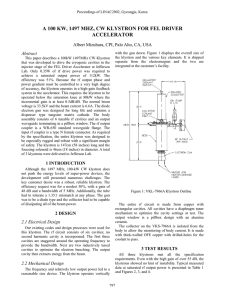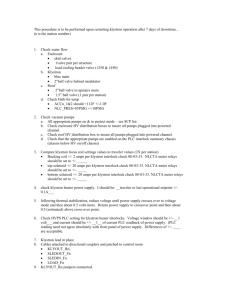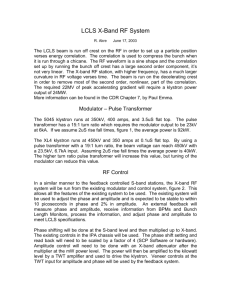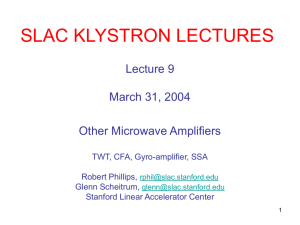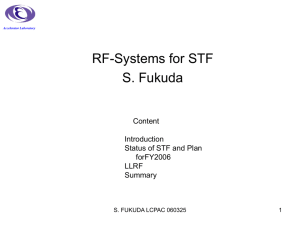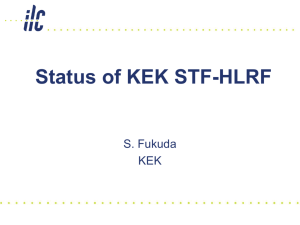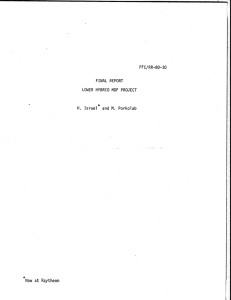Patrick Prejcik
advertisement
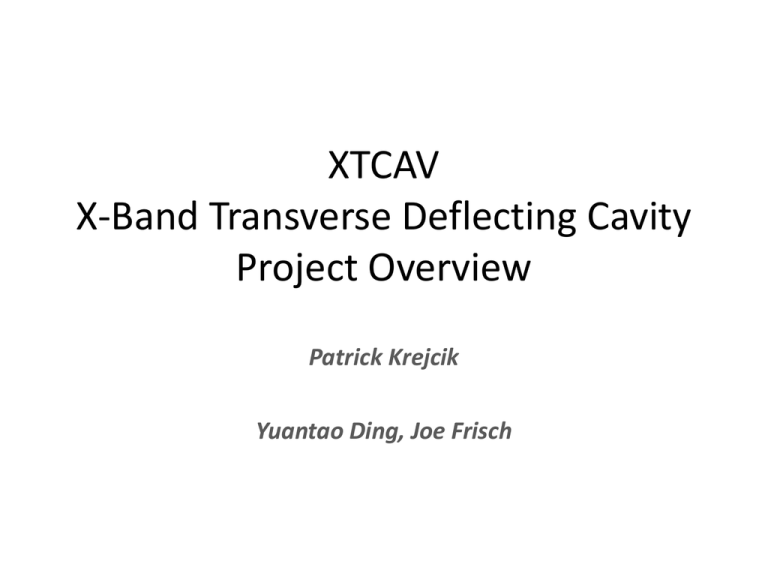
XTCAV X-Band Transverse Deflecting Cavity Project Overview Patrick Krejcik Yuantao Ding, Joe Frisch Layout of the Undulator to Dump Beam Line Simulation example - Yuantao Ding low charge 20pC soft x-rays OTRDMP FEL ON FEL OFF head Current “measurement” X-ray “measurement” Penetration Penetration to B921 XTCAV Proposed Location Conceptual sketch of the x-band structure and waveguide on the beam line. Structure Fabrication • One structure built and tested • Second structure Item Fab 2nd deflector structure Shop labor Direct labor $98,448 $16,800 M&S Program support Indirects Total $10,000 $1,680 $61,743 $188,671 • Support stand, beam line and vacuum installation • ~$390k 1m B921 and undulator tunnel elevation view showing penetration for waveguide to the XTCAV Excerpt from the floor plan of B921 with proposed modulator and klystron locations B921 floor space for modulator and klystron Penetration B921 cross-section showing available elevation with respect to cable trays and ceiling Commercially available Modulator installation housing the SLAC XL4 klystron. • • • • • Much better pulse stability than SLAC modulator: 30 ppm versus 100 ppm Complete system houses klystron, magnet, oil tank and output transformer EPICS controls interface “turn-key” system purchase price ~$650k LCLS motivated to evaluate this modulator for other applications e.g. L1S • Also purchased by LLNL, Trieste, CLS, CERN … Output from the klystron goes through a mode converter to circular waveguide for lower power loss Fabrication and installation of waveguide components: including converters splitters, couplers, loads and vacuum components, all based on existing SLAC Xband designs ~$365k LLRF Phase reference – Share the low-noise 476 MHz heliax from the linac with the beam phase monitor – Beam based feedback corrects slow drifts 476 MHz XTCAV Cavity EPICS Controls • • • • LLRF - (next slide) Vacuum - status of new pumps, gauges and valves Profile Monitor OTRDMP - present camera is only 10 Hz (upgrade?) Feedback – orbit at BPMUE1, BPMUE2 and BPMUE3 after the XTCAV to stabilize the RF phase of cavity and keep the bunch at the zero phase crossing • PPS – Modulator interlocked to Access state – Review to show existing BTMs give adequate coverage • BCS – New spoiler at end of XTCAV – Review to show existing PICs give adequate coverage • MPS – Set threshold of MPS BLMs lower than BCS PICs Why PPS, BCS and MPS are important • Beam at the wrong phase can be kicked by up to 10 mrad – Lowest energy beam, highest amplitude RF, phase at crest • Beam leaves the beam pipe within the XTCAV already • Existing safety systems have large acceptance angle. e.g. BTMs LLRF EPICS Controls • Use LCLS PADs and PACs with EPICS IOC and BSA • Use either MKSU II for klystron and modulator interlocks, or Scandinova integrated controls • In the linac CAMAC PDU still provides timing to the modulator via the PIOP module • Consider the LLRF control system as a whole: – The XTCAV will be the first stand-alone RF station with EPICS-only controls – There are choices of platforms on which to implement EPICS • • • Linac Phase I upgrade with EPICS driver for CAMAC Replace CAMAC modules with VME modules and EPICS timing, similar to existing EPICS architecture. Develop a new mTCA platform – Need to be able to this in < 2 years – The choice we make here will set a precedent for the LCLS-2 injector project Cost Summary System Fabrication of second XTCAV structure Mechanical and vacuum installation Waveguide system Klystron and focusing magnet Modulator and klystron tank Electrical AC Service Cooling systems LLRF Drive system LLRF controls PPS, BCS and MPS Profile Monitor Total Including 25% Contingency Including Estimated Cost Indirects $126,928 $188,671 $390,240 $365,200 $492,227 $745,000 $115,000 $128,000 $271,500 $352,000 $100,000 $20,000 $390,240 $564,900 $690,675 $855,000 $168,130 $157,564 $334,295 $505,027 $150,000 $30,000 $3,106,095 $4,034,502 $5,043,128
